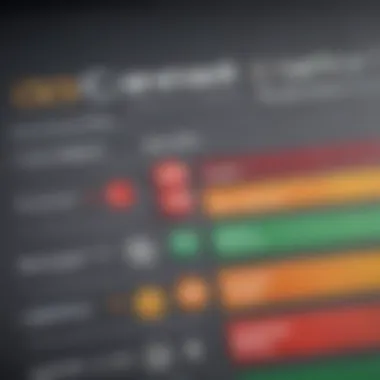Understanding Home Loan Eligibility Criteria


Intro
Navigating the world of home loans can feel like stepping into a labyrinth. For many, a home is not just a roof over their heads but a substantial financial investment and often a lifelong dream. Understanding the eligibility criteria for home loans is paramount for anyone looking to make this leap. As the old saying goes, "Knowledge is power," and in this context, being informed can enhance your chances of securing that coveted loan.
From the nuances of credit scores to the intricacies of debt-to-income ratios, each of these elements plays a crucial role in the decision-making of lenders. In this article, we delve into these factors, providing a comprehensive overview of what it takes to qualify for a home loan. Knowing the ropes will equip prospective buyers to present themselves as worthy candidates in the eyes of lenders.
Investment Dictionaries
Understanding the language of home loans is vital. Familiarizing oneself with key financial terms can demystify the process and help one communicate effectively with lenders.
Common Financial Terms
- Credit Score: This three-digit number, ranging from 300 to 850, reflects a borrower's creditworthiness. Higher scores signal less risk to lenders.
- Debt-to-Income Ratio (DTI): This ratio compares your monthly debt obligations to your gross monthly income. A lower DTI is favorable when applying for loans.
- Down Payment: This is a percentage of the home's purchase price that must be paid upfront. Generally, a larger down payment can lead to better loan terms.
Advanced Investment Terminology
- Amortization: This is the process of paying off a debt over time through regular payments. Knowledge of amortization schedules can help borrowers understand how their payments affect outstanding loan balances over time.
- Principal: The original loan amount before interest. Understanding the principal is crucial when calculating overall costs and interest payments.
- Equity: This refers to the difference between what you owe on your home and its current market value. Building equity leads to greater financial stability.
Understanding these terms is akin to having a roadmap while navigating your home loan journey. In a field where clarity often gets lost amid jargon, grasping these concepts can make a significant difference.
"It's better to be prepared and not have an opportunity than to have an opportunity and not be prepared." - Whitney Young
Expert Advice
The home loan landscape can be overwhelming, but expert guidance can illuminate the path. It's beneficial to tap into professional advice to tailor strategies that suit individual circumstances.
Tailored Investment Strategies
Homebuyers should consider the various loan options available. For instance, conventional loans, FHA loans, and VA loans serve different types of borrowers. Each has specific qualifications that can affect interest rates and down payment requirements.
It's wise to assess your financial situation and objectives carefully before settling on a loan type. Partnering with a knowledgeable mortgage broker can also help in finding the most favorable terms.
Risk Management Techniques
One often overlooked aspect of borrowing is planning for contingencies. Homebuyers should not only consider their current financial state but also anticipate changes that may affect their ability to repay the loan over time. Establishing a solid financial buffer can mitigate risks associated with unforeseen circumstances.
The journey to obtaining a home loan may seem daunting at first, but with clarity, informed decisions, and wise strategies, it's possible to transform dreams into reality. By understanding the eligibility criteria and arming oneself with the right knowledge, prospective buyers can approach lenders with confidence.
Understanding Home Loans
Understanding home loans is crucial for anyone looking to purchase property. It clarifies how finance works in the housing market, helping future homeowners make informed decisions. Home loans serve as a lifeline for many, transforming the dream of homeownership into reality by providing capital that most individuals don’t have readily available. This section sheds light on fundamental concepts, aids in navigation through complex jargon and terms, and enhances comprehension about types and nuances of mortgages.
Definition of Home Loans
At its core, a home loan is a borrowed sum of money used to purchase a house. The borrower agrees to repay this amount, plus interest, over a set period—usually between 15 and 30 years. Home loans can be secured against the property, meaning if mortgage repayments falter, the lender has the right to reclaim the house. This relationship between lender and borrower is formalized through a mortgage agreement, outlining the amount borrowed and the terms of repayment.
Types of Home Loans


When it comes to obtaining a home loan, there is no one-size-fits-all solution. Different types of loans cater to varied financial situations, borrower profiles, and property types. Let's explore some common types that are offered in today’s market, each of which have distinct characteristics and advantages.
Conventional Loans
Conventional loans, as the name suggests, are the most widely recognized type of home loan. They are not backed by any government agency. These loans often come with stricter credit requirements but generally offer lower interest rates, making them a popular choice for financially stable individuals. A key characteristic of conventional loans is flexibility; borrowers can choose various terms and not be limited by government guidelines. However, they typically require a larger down payment—around 20%—which can be somewhat of a barrier for first-time buyers.
FHA Loans
FHA loans, backed by the Federal Housing Administration, are designed to make homeownership accessible for those with lower credit scores or smaller down payments. One major aspect of FHA loans is the reduced down payment requirement, which can be as low as 3.5%. This feature makes it a beneficial option for many first-time homebuyers. However, borrowers must pay for mortgage insurance premiums, which can add to the overall cost of the loan, making it vital to weigh all aspects before committing.
VA Loans
VA loans are specifically designed for veterans, active-duty military members, and some surviving spouses. They offer a distinctive edge because they do not usually require a down payment, making them incredibly attractive for those eligible. A standout characteristic is also the lack of private mortgage insurance (PMI), which substantially reduces monthly payments. On the flip side, one must be a qualified service member to access these loans, limiting their availability only to a certain group.
USDA Loans
USDA loans target rural and suburban homebuyers who meet specific income requirements. Such loans are noteworthy because they offer a zero down payment opportunity, thereby removing a common hurdle many face. This characteristic makes the USDA loan accessible to lower-income households. However, these loans are restricted to particular areas, and eligibility is dependent on meeting certain income limits. Hence, while they are advantageous, the geographical and income restrictions could be viewed as disadvantages to some buyers.
Each loan type caters to various needs and situations. Understanding these differences can help potential borrowers choose the path that best fits their unique circumstances.
Eligibility Criteria Overview
When it comes to home loans, understanding the eligibility criteria is crucial for anyone looking to buy a house. Paring down to the nitty-gritty of what lenders assess can make the difference between getting an approval or facing a rejection. It's not just about having a good credit score or a steady job; it’s about showing lenders a well-rounded picture of your financial health.
Importance of Meeting Criteria
Let’s break it down. Meeting eligibility criteria isn’t merely a box-ticking exercise; it’s about demonstrating your capability to repay the loan. Lenders want assurance that you’re not a financial gamble. When you meet these benchmarks, you not only increase your chances of approval but also position yourself for better interest rates. This leads to substantial savings over the life of the loan, making it crucial to prepare your financial profile accordingly.
Consider the implications here: if your credit score is a smidge below average, lenders might interpret that as a red flag, even if your income and debt ratios are solid. Likewise, a hefty down payment can mitigate concerns regarding your credit history. Essentially, you need to know the rules of engagement in this financial game.
Here's a quick look at why it matters:
- Financial Stability: Proving you can manage your finances well.
- Better Interest Rates: Meeting criteria can lead to lower rates.
- Increased Approval Chances: A solid profile gives lenders confidence.
Impact of Lender Policies
Delving into the role of lender policies sheds more light on the eligibility criteria. Not all lenders operate with the same set of guidelines. Some might be more flexible, while others adhere strictly to conventional norms. This variability could significantly affect your chances of being granted a home loan.
For instance, consider a specific scenario: You approach two lenders. Lender A prides itself on a rigorous credit score requirement, demanding a minimum score of 720, while Lender B is willing to accept scores from 620 and above. This simple difference can open avenues you wouldn't otherwise explore.
Moreover, lender policies get influenced by market conditions and overall economic health. During tougher economic times, lenders may tighten their belts, applying stricter criteria to safeguard their investments. It’s essential, therefore, to do your homework on each lender’s stipulations and prepare accordingly. Knowing their specific requirements and policies can help tailor your application to better fit their profile.
Credit Score Requirements
When looking at eligibility for home loans, credit scores take center stage. Not only do they act like a report card on your borrowing history, but they also play a pivotal role in determining the shape of your mortgage terms. A high credit score can unlock better interest rates and even lower monthly payments, while a low score might limit your options or lead to higher expenses. Thus, understanding the ins and outs of credit scores is crucial for any aspiring homeowner.
Understanding Credit Scores


A credit score is, essentially, a numerical reflection of your creditworthiness. It ranges, typically, from 300 to 850, with higher scores indicating better credit management. This score is influenced by various factors, including payment history, amounts owed, length of credit history, new credit, and types of credit in use. For prospective borrowers, comprehending these factors can make a significant difference in loan eligibility. The higher the score, the more favorable the loan conditions.
Minimum Credit Scores by Loan Type
Different home loans have distinct minimum credit score requirements that stem from their varying risk assessments. Here’s a broad breakdown:
Conventional Loans
Conventional loans often require a minimum credit score of around 620. This is an attractive option for many since conventional loans are not federally insured. They can offer lower mortgage insurance costs compared to government-backed loans. The principal characteristic of conventional loans is their flexibility—they can be used for multiple property types, including primary residences, secondary homes, and investment properties. However, their requirements may be strict for those with just average credit. A strong score can lead to better interest rates.
FHA Loans
FHA loans are designed with first-time buyers and those with lower credit scores in mind. The minimum credit score is typically around 580 for those who can make a 3.5% down payment. A key characteristic of FHA loans is the leniency they provide in terms of eligibility, making them a popular choice. They require mortgage insurance, but the overall costs can be lower for those who may not qualify for traditional loans. However, the presence of mortgage insurance can increase overall lifetime costs.
VA Loans
For eligible veterans and active-duty military personnel, VA loans offer some of the most attractive terms available. There is no specified minimum credit score for VA loans, but many lenders request a score around 620 or above. What sets VA loans apart is the absence of a down payment requirement and mortgage insurance, making them incredibly beneficial in terms of long-term financial planning. However, it’s crucial to understand that not all lenders will follow the same guidelines, and some may have stricter standards in place regarding credit scores.
USDA Loans
USDA loans, aimed at providing homeownership in rural areas, generally require a minimum credit score of 640. These loans come with unique favorable features like no down payment and attractive interest rates. The main characteristic of USDA loans is their focus on assisting those in eligible rural regions. However, applicants must also meet income restrictions that tie back to approval eligibility.
Ways to Improve Your Credit Score
Improving your credit score isn’t an overnight success. It requires diligent financial habits and smart decisions:
- Pay bills on time: This accounts for a significant portion of your credit score.
- Reduce existing debt: Aim to lower your credit utilization to below 30%.
- Avoid opening new credit lines unless necessary: New inquiries can temporarily lower your score.
- Check credit reports for errors: Sometimes mistakes happen, which can drag your score down.
- Keep old credit accounts open: Length of credit history is a factor—so the older, the better.
Improving credit scores requires time and patience. But the payoff can be substantial when it comes to securing a favorable home loan.
"Good credit is more than just a number; it’s a ticket to better financial opportunities."
By focusing on these aspects, aspiring homeowners can position themselves for success when applying for a mortgage.
Income Verification Process
Understanding the income verification process is crucial for anyone looking to tap into the realm of home loans. Lenders scrutinize your income to gauge whether you can manage monthly mortgage payments without stretching your finances to the limit. Assessing this aspect can make or break your loan application, as it provides a clear picture of your financial capability.
The importance of income verification can't be overstated. It’s not just about how much you make; it’s about proving you have a steady and reliable source of income that can cover your ongoing expenses and the new responsibility of a mortgage. This process is designed to protect both lenders and borrowers, ensuring that individuals don’t bite off more than they can chew when it comes to their financial obligations.
Documentation Requirements
When it comes to documentation, lenders typically want a detailed overview of your earnings to make an informed decision. This includes but is not limited to:
- Pay Stubs: Recent pay stubs, usually covering the last 30 days, serve as a snapshot of your current earnings.
- Tax Returns: Lenders often ask for the last two years of tax returns. This showcases your income history and ensures consistency.
- W-2 Forms: These forms provide a summary of your annual earnings and are a critical element in assessing your financial profile.
- Bank Statements: Recent bank statements, generally from the last two or three months, help to show your spending habits and any additional income sources.
Providing comprehensive and accurate documentation is essential. Missing or incorrect information can delay the loan process significantly.


Calculating Stable Income
First off, calculating stable income can sometimes feel like a daunting task, especially for those with fluctuating paychecks. Lenders want to see a reliable income stream that assures them you can fulfill your loan obligations month after month.
Commonly accepted forms of income may include:
- Salary: A fixed income is straightforward. Your lender will typically look at your gross salary before deductions.
- Bonuses and Commissions: If you earn bonuses or commissions, lenders usually average these over the past two years to gauge stability.
- Rental Income: For those collecting rent from properties, lenders generally require documentation showing a consistent rental history.
- Self-Employment Income: If you are self-employed, calculations can take a different route; lenders will analyze your net income after expenses and may also review your business financials.
In essence, it's all about showing the lenders that your income isn’t just a flash in the pan but rather a consistent part of your financial narrative. Confirming the starting point of your financial journey with solid documentation will only serve to bolster your case.
"A solid income verification process not only facilitates a smoother transaction but also assures lenders that you are accountable and responsible with your finances."
By grasping the ins and outs of the income verification process—and taking the time to organize the required documentation—you stand a better chance of securing that home loan you’ve been eyeing.
Employment Stability and History
In the realm of home loan eligibility, the aspect of employment stability and history cannot be brushed aside. For lenders, a steady job history isn’t just a box to tick; it serves as a window into a borrower's financial future. Essentially, lenders seek more than just numbers; they want assurance—assurance that you’ve got a reliable source of income to support your mortgage payments over time.
Having a consistent employment record can significantly bolster one’s chances of loan approval. It paints a picture of stability and dependability, attributes that every lender appreciates. If you’ve held a job for a substantial period, it suggests that you are less likely to default on your loan, therefore making you a more appealing candidate.
Importance of Employment History
Your employment history acts like a thread woven through the fabric of your financial profile. It should logically detail not just where you've worked, but also how long you've remained in each position. Here are some critical benefits of a solid employment record:
- Increases Trust: Having a steady job increases your credibility. Lenders feel more comfortable knowing you can handle long-term financial commitments.
- Higher Loan Amounts: A strong employment history often translates to larger loan amounts. Lenders are more inclined to offer substantial sums of money if your job history supports it.
- Lower Interest Rates: Stability might even lead to better interest rates. Lenders are more likely to offer favorable terms to borrowers they perceive as low-risk.
The nature of your job also plays a pivotal role. For example, government employees or workers in established companies are often viewed more favorably compared to those in transient or freelance positions. This isn’t to say that freelancers can’t secure a loan; it’s merely that you may have to jump through a few more hoops to prove your income stability.
Additionally, gaps in employment can carry weight in the eyes of lenders. If you've been unemployed for a while, it could raise red flags about your stability and, by extension, your ability to repay a loan. Addressing these gaps upfront and explaining them clearly in your application can help mitigate any concerns a lender might have.
Job Changes and Loan Applications
In today’s fast-paced world, job changes are quite common, and lenders understand that life happens. However, it’s crucial how you navigate those changes when applying for a loan. A sudden shift in your job can affect your loan application.
- Timing Matters: If you change jobs just before applying for a home loan, it could hinder your approval chances. Lenders typically prefer to see at least 6 to 12 months at a new job before considering you a safe bet.
- Proving Consistency: When shifting jobs, especially to a position that pays more, ensure you can demonstrate how these job changes lead to increased stability. Perhaps it's within the same industry or a promotion; these factors can work in your favor.
- Document Everything: Any changes in your employment should be transparently communicated to the lender, preferably with accompanying documents that validate your new role, salary, and how long you've been there.
As important as it is to put your best foot forward without embellishing your history, it’s equally vital to convey a narrative of stability, even amid job changes.
"A steady job history speaks volumes to lenders—it’s not just about what you earn, but how reliably you earn it."
Debt-to-Income Ratio
The debt-to-income ratio (DTI) is a crucial marker in the home loan approval process. It measures the portion of a borrower's gross monthly income that goes toward monthly debt payments. When lenders assess an applicant's ability to repay a loan, they take a close look at their DTI. A high ratio signals that a borrower may already be stretched too thin financially, while a lower ratio suggests they can comfortably handle additional monthly payments.
Understanding this metric helps prospective borrowers gauge their financial health and make informed decisions before applying for a home loan. After all, it's not only about having a good credit score; your DTI can make or break your chances of securing a mortgage.
Defining Debt-to-Income Ratio
To further clarify, the debt-to-income ratio is calculated by dividing total monthly debt payments by gross monthly income, then multiplying by 100 to get a percentage. For instance, if a borrower earns $5,000 a month and has monthly debts totaling $1,500, the DTI would be computed as follows:
DTI = (Total monthly debts / Gross monthly income) * 100 DTI = ($1,500 / $5,000) * 100 = 30%







